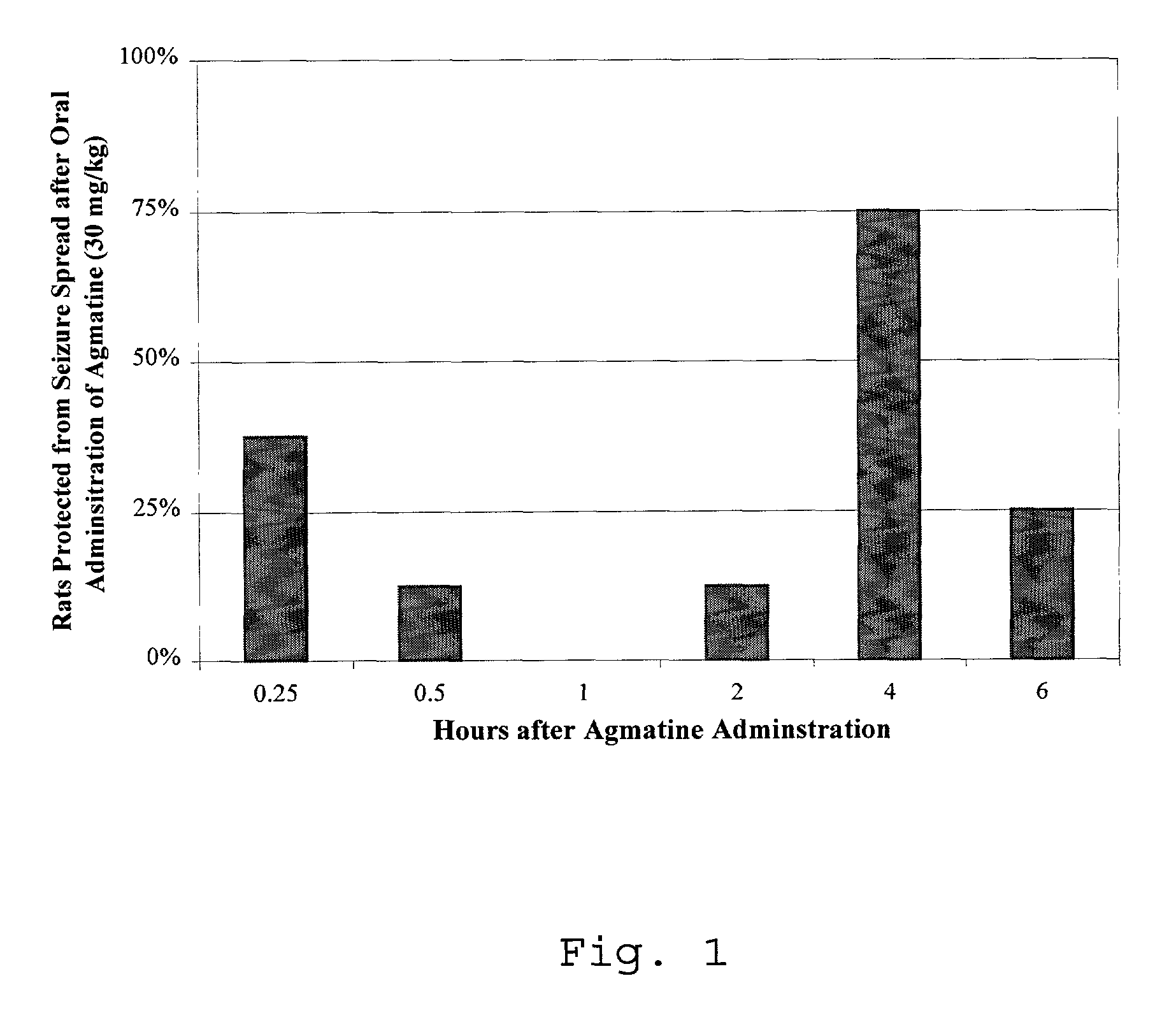Agmatine and agmatine analogs in the treatment of epilepsy, seizure, and electroconvulsive disorders
a technology of epilepsy and electroconvulsive disorders, applied in the field of agmatine and analogs, can solve the problems of drug interactions, unfavorable patient treatment, and inability to fully absorb agmatine, so as to achieve the effect of treating, preventing and/or ameliorating disorders
- Summary
- Abstract
- Description
- Claims
- Application Information
AI Technical Summary
Problems solved by technology
Method used
Image
Examples
example 1
The Maximal Electroshock Seizure (MES) or Maximal Seizure Pattern Test
[0049]The MES is an experimental model for generalized tonic-clonic seizures that identifies compounds which prevent seizure spread. The MES model is highly reproducible and has a consistent endpoint. An advantage of this model is that the behavioral and electrographic seizures are consistent with those observed in humans (Levy, R. H., Antiepileptic drugs. 3rd Ed. 1989, New York: Raven Press. xxvii, 1025. p. 85-102).
[0050]In the MES test, the animal receives an electrical stimulus, 0.2 seconds in duration, via corneal electrodes primed with an electrolyte solution containing an anesthetic agent. The 0.2 second stimulation is generated with 150 mA in rats at 60 Hz. Twenty rats, weighing between 105 g and 130 g receive an electrical stimulus 15 minutes, 30 minutes, 1 hour, 2 hours, 4 hours, 8 hours and 12 hours after oral administration of a dose of about 30 mg / kg of agmatine in phosphate buffered in saline per kg o...
example 2
Minimal Neurotoxicity
[0052]Toxicity in mice and rats is assessed using three screens: the rotorod in mice, positional sense, and gait in rats. In mice, the test compound is administered at doses of 30, 100, and 300 mg / kg prior to evaluation in the toxicity screens. The mice are tested 0.5 hours and 4 hours after administration of the test compound. In rats, the test compound is administered at 30 mg / kg prior to the toxicity assessment. The rats are tested at 0.25, 0.5, 1, 2, and 4 hours after administration of the test compound.
[0053]Rotorod Test
[0054]Toxicity in mice weighing between 20.5 and 25.5 g is assessed using the standardized rotorod test (Dunham, M. S. and T. A. Miya, A note on a simple apparatus for detecting neurological deficit in rats and mice, J. Am. Pharm. Assoc. Sci. Edit (1957) 46:208-209). Control mice can maintain their equilibrium for an extended period of time when they are placed on a 6 rpm rotation rod. Neurologically impaired animals cannot maintain equilibr...
PUM
| Property | Measurement | Unit |
|---|---|---|
| weight | aaaaa | aaaaa |
| tonic-clonic | aaaaa | aaaaa |
| hygroscopic | aaaaa | aaaaa |
Abstract
Description
Claims
Application Information
 Login to View More
Login to View More - R&D
- Intellectual Property
- Life Sciences
- Materials
- Tech Scout
- Unparalleled Data Quality
- Higher Quality Content
- 60% Fewer Hallucinations
Browse by: Latest US Patents, China's latest patents, Technical Efficacy Thesaurus, Application Domain, Technology Topic, Popular Technical Reports.
© 2025 PatSnap. All rights reserved.Legal|Privacy policy|Modern Slavery Act Transparency Statement|Sitemap|About US| Contact US: help@patsnap.com



